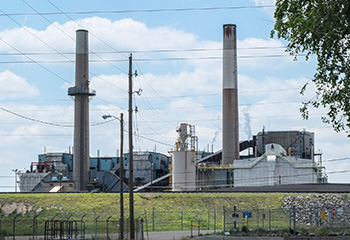2016 News & Events
Aerosol Sulfate Trends and Their Effect on Photosynthesis
21 October 2016

There are many factors involved in cleaning up air pollution. The Clean Air Act controlled SO2 and NOx emissions from power plants, and these pollutants affect ecosystems in several ways, including acid rain, ozone, and nitrate deposition. With detailed analysis of scattered light and photosynthesis, researchers have added one more piece to the puzzle of understanding how aerosol pollution indirectly affects ecosystems.
Rebecca Washenfelder, a CIRES scientist at CSD, and Gretchen Keppel-Aleks from the University of Michigan examined the effects of decreasing sulfate emissions in the eastern United States. "The effect of atmospheric sulfate reductions on diffuse radiation and photosynthesis in the United States during 1995-2013" was published in Geophysical Research Letters, a publication of the American Geophysical Union.
Atmospheric aerosols are microscopic particles suspended in the air that reduce visibility and play other important roles in the environment. Aerosols directly affect the earth's climate by scattering and absorbing sunlight. Indirectly, aerosols can affect the earth's climate by causing changes in clouds or ecosystems. One of the links between aerosols and ecosystems is due to light scattering. The scattered light from aerosols reaches more of the leaf surfaces of plants, leading to greater photosynthesis.

Aerosols can be emitted both naturally and anthropogenically. Sulfur dioxide (SO2) is one of the main sources of anthropogenic aerosols and is released from coal-fired power plants and industrial processes. In the atmosphere, this gas is oxidized to form sulfate aerosols, leading to poor air quality. In the United States, the 1990 Amendments to the Clean Air Act reduced SO2 emissions significantly, giving researchers a perfect opportunity to examine the effects of reduced sulfate aerosol mass.
This study examined the influence of SO2 emissions on light scattering, and how that affects the rate of photosynthesis, called gross primary productivity. Because accurate emission data is available for the eastern United States from 1995 to 2013, this made for an ideal region to study. As a result of emission controls, SO2 emissions decreased by 70 percent for the United States during that period. Keppel-Aleks and Washenfelder used two approaches to examine how this large SO2 decrease affected ecosystems. One approach used published relationships between scattered light and photosynthesis for different ecosystems together with ecosystem maps to make calculations for the eastern United States. The second approach used the Community Earth System Model to simulate the effects of decreased SO2 emissions on aerosol optical depth, surface radiation and photosynthesis. Both satellite data and the model showed similar decreases in aerosol optical depth in the eastern United States during the study period. Because the model results agreed with actual satellite measurements, researchers were able to continue with this model as an accurate simulation of direct and scattered light patterns.
G. Keppel-Aleks, R. A. Washenfelder, The effect of atmospheric sulfate reductions on diffuse radiation and photosynthesis in the United States during 1995-2013, Geophysical Research Letters, doi:10.1002/2016GL070052, 2016.
Abstract
Aerosol optical depth (AOD) has been shown to influence the global carbon sink by increasing the fraction of diffuse light, which increases photosynthesis over a greater fraction of the vegetated canopy. Between 1995 and 2013, U.S. SO2 emissions declined by over 70%, coinciding with observed AOD reductions of 3.0 ± 0.6% yr−1 over the eastern U.S. In the Community Earth System Model (CESM), these trends cause diffuse light to decrease regionally by almost 0.6% yr−1, leading to declines in gross primary production (GPP) of 0.07% yr−1. Integrated over the analysis period and domain, this represents 0.5 Pg C of omitted GPP. A separate upscaling calculation that used published relationships between GPP and diffuse light agreed with the CESM model results within 20%. The agreement between simulated and data-constrained upscaling results strongly suggests that anthropogenic sulfate trends have a small impact on carbon uptake in temperate forests due to scattered light.